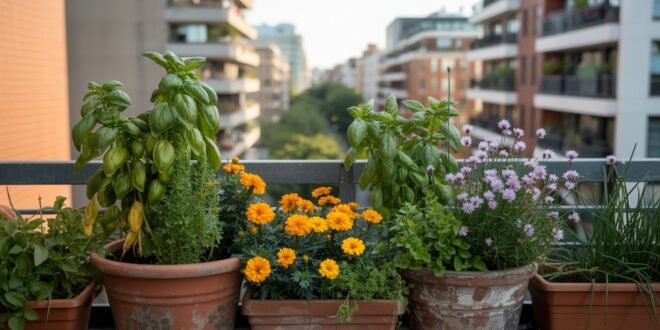Imagine plucking breakfast tomatoes from rail-hugging pots—that’s the thrill of a balcony vegetable garden. Last spring my eight-foot nook became a three-tier jungle that muffled traffic and smelled like lavender and mint.
Stick around and you’ll snag three wins: learn smart vertical tricks that spare floor space, rotate crops for nonstop harvests, and spice the air with herbs and flowers that welcome bees while nudging pests away.
Ready to climb to that first vertical planter?
Maximize vertical grow space
Tiny balcony, giant dreams? No problem. This section shows how to garden upward so every rail, wall, and ceiling hook turns into salad, salsa, or snacking berries. First, you’ll meet rail planters that hug the balcony edge and clear the floor for your morning chair. Then we’ll look up to hanging baskets that dangle fruit like living ornaments. By the end, you’ll see how height hides clutter and keeps weight spread out. Let’s climb!
A balcony vegetable garden that stretches sky-ward leaves plenty of legroom for yoga, weekend naps, or a friend’s folding chair. Better yet, lifting plants into the sunshine means stronger stems and fewer pests crawling in from below. The extra airflow also keeps leaves dry, cutting down on mildew. So grab that tape measure, think tall, and watch your edible jungle sail right over the rail.
Stack rail planters
Rail boxes sit at eye level, giving herbs and greens a front-row seat to the sun while freeing the floor. They’re also easy to water without bending like a rusty hinge.



Go wide, not skinny
Skinny boxes dry out in a flash. Pick planters wider than a loaf of bread so roots stay cool and damp. The extra width holds more soil, which means fewer water runs and steadier growth. It also stops top-heavy plants from tipping after a windy afternoon.
Depth matters
Leafy greens are happy with six inches of soil. Peppers like eight. Check the depth before planting or you’ll end up with mini carrots—whether you wanted them or not. Deeper boxes store more nutrients, so plants stay full and leafy.
Layer plants like a sandwich
Tuck short lettuces in back and let thyme or nasturtiums drape over the front. This “living waterfall” shades bare soil, keeps moisture in, and looks pretty enough for photos. You’ll harvest more crops from the same spot without crowding friends for balcony space.
Strap them down
Storm coming? Use sturdy brackets or a backup strap so the box stays put. Scratches on the rail are no fun and neither is chasing a runaway planter down the street.
Rail boxes create a handy eye-level salad bar. You water, snip, and munch without moving your feet. Plus, the balcony floor stays open for coffee cups and conversation.
Quick tip: Slide a thin plastic tray under each rail box. It catches drips before they mark the neighbor’s patio, and you can use the saved water on thirsty plants later.
Hang trailing baskets
Look up—there’s real estate above your head begging for plants. Hanging baskets turn plain air into a floating orchard.


Pick draping stars
Choose strawberries, dwarf tomatoes, or small chilies that spill over the rim. Fruit stays cleaner off the ground and looks like it’s dangling from a snack chandelier.
Watch the thirst
Coco or moss liners drain fast. Stick a finger into the soil each morning; if it feels dry, soak the basket until water drips out the bottom. Regular drinks keep berries juicy instead of raisin-like.
Hide from harsh wind
If your balcony acts like a wind tunnel, hang baskets closer to the wall. A little shelter stops stems from snapping and flowers from blowing away.
Hanging baskets frame your view with tumbling produce, freeing the rail for other plants—or that extra glass of iced tea. Moving food up high also makes room for a folding chair down low. Easy, breezy snacking at arm’s reach.
How to: Thread a simple S-hook through a ceiling eye bolt, then clip the basket chain onto it. This setup lets you lift baskets down for watering without climbing a ladder.
Harvest balcony vegetable garden bounty
You don’t need acres to eat fresh. This part shows how pint-size tomatoes, peppers, and greens keep the bowls full from spring to fall. First, meet dwarf tomatoes that can’t stop fruiting. Next, salad boxes that bounce back after every cut. Ready for nonstop munching?
A balcony vegetable garden pays rent in ripe bites. Matching small plants to small pots avoids crowding and makes watering simple. Even better, you can pick breakfast seconds before eating it—no fridge required. Living in an apartment has perks, and a fresh harvest right outside the door is one of them.
Compact tomatoes and peppers
Small but mighty, these plants pump out flavor without hogging space.


Choose pint-size champs
Look for tomatoes labeled “dwarf” or “determinate.” They top out at knee height yet crank out sweet red spheres. Tiny plants fit in a sunny corner and still feed a family of snackers.
Give roots room
One plant per three-to-five-gallon fabric bag keeps moisture steady. Cramming two plants in one pot sounds thrifty but ends with leaf fights and fewer fruits.
Chase the sun
Six hours of direct light turns sugar up to max. Rotate the pot every week so stems grow straight instead of leaning like sleepy sunflowers.
Pick peppers that behave
Jalapeños and small Thai chilies thrive in the same bag size. They set fruit even when breezes wiggle the stems, so balcony wind isn’t a deal-breaker.
Harvest early, harvest often
Snip ripe pods and tomatoes every few days. The plant thinks, “Oh no, fruit is gone!” and makes more blossoms. Free production hack.
Tomatoes and peppers become MVPs when given light, space, and quick pick-me-ups. Your salsa bowl may beg for mercy by midsummer.
Pros & Cons: Pros: bright flavor, colorful pots, endless recipes. Cons: leaving town for a week means calling a plant-sitter with watering skills.
Salad greens in shallow boxes
Greens love the balcony life. They don’t need deep soil, and they regrow after every haircut.


Shallow soil, deep flavor
Lettuce roots are short. A six-inch window box is plenty. The shallow depth also keeps weight light for fragile rails.
Go wide for moisture
Boxes at least eighteen inches across hold more dirt and stay damp longer. You water less, the plants stay happier, and nobody wilts mid-day.
Snip and repeat
Trim outer leaves with scissors. The center keeps growing so you get three or four harvests before heat tells the plant to bolt.
Gentle sunshine
Morning light or light shade in the afternoon stops edges from burning while still powering leaf growth.
Damp, not swampy
Finger-test the soil. If it feels dry an inch down, water. If mud sticks to your finger, wait. Roots like to breathe too.
Shallow planters turn any ledge into a living salad bar. Fresh greens on demand beat limp grocery bags every time.
Quick tip: Mix colorful varieties—green butterhead, red romaine, and speckled oakleaf—for a bowl that looks as good as it tastes.
Design a lush edible living screen
Privacy plus snacks—yes, you can have both. First, we’ll stack thrillers, fillers, and spillers for a leafy wall. Then we’ll line up dwarf citrus trees that double as room fresheners. Goodbye nosy neighbors, hello homegrown fruit.
A living screen softens hard balcony lines and masks street noise with rustling leaves. It also shades windows in summer, cutting heat inside the apartment. Growing food in the privacy wall means every square foot earns its keep. City life just got greener and tastier.
Thrillers fillers spillers combos
Mix tall climbers, mid-level greens, and trailing treats in one pot for a layered feast.



Tall climbers steal the show
Pole beans dash up a slim trellis, reaching the top rail fast. They weave a dense curtain of leaves and dangle pods at eye level. Talk about functional decor.
Bushy mid-layer fills gaps
Kale, chard, and basil puff out in the center, hiding bare stems. Their ruffled textures look lush and make salads prettier.
Trailing ends add flair
Nasturtiums or ever-bearing strawberries spill over the lip. They hide the pot rim and offer peppery leaves or sweet berries for snacking.
Planting all three tiers packs one container with triple harvests. The pot looks full from day one and keeps getting better.
How to: Insert a slim trellis into the pot before adding soil. This avoids stabbing roots later and keeps the setup sturdy against summer storms.
Privacy with dwarf citrus trees
Mini trees act like living curtains that smell like vacation.


Pick real dwarfs
Meyer lemons or calamondins stay under six feet in a 15-gallon pot. Small size, big flavor—it’s a balcony win.
Line them up
Set three matching tubs along the rail. Together they read as one sleek hedge and spread weight evenly.
Train for cover
Tie young branches to a narrow trellis so foliage fills side gaps. You’ll block stares without blocking the breeze.
Underplant smartly
Thyme or oregano at the base shade citrus roots and give you extra herbs. Double harvest, same pot.
A citrus hedge gives glossy leaves year-round, spring perfume, and enough fruit for weekend lemonade—all while screening curious eyes.
Pros & Cons: Pros: evergreen beauty, great scent, fresh fruit. Cons: heavy pots need sturdy floors and winter protection in cold zones.
Simplify watering and care routines
Watering cans get heavy fast. Here you’ll meet self-watering pots that sip slowly and rolling caddies that save your back. Less hauling, more hammock time—yes, please!
Smart gear keeps your balcony vegetable garden thriving even on busy weeks. The right setup lets you leave for a mini trip without coming home to crispy lettuce. Airflow improves, pests stay away, and your apartment deck feels more like a tiny park than a chore list.
Self-watering containers
Hidden reservoirs give plants a steady drink while you relax.


Let reservoirs handle thirst
Self-watering pots feed roots from below, avoiding the dry-soak cycle that stresses plants. Fill the tube, and you’re done for days.
Make a budget bucket
A five-gallon pail with a simple wick keeps herbs perky. It’s weekend-project easy and saves daily watering.
Group similar drinkers
Cluster thirsty greens together so you refill one tray instead of chasing pots like a game of whack-a-mole.
Mulch the surface
A light straw layer cuts evaporation and cools roots. Moisture sticks around longer, and weeds can’t crash the party.
Top up, don’t flood
Wait until the reservoir is almost empty, then refill. Roots like oxygen as much as water.
With reservoirs below and mulch above, plants coast through hot afternoons. You spend more time eating than watering.
Quick tip: Stick a wooden skewer into the soil; if it comes out dry, add water. No fancy meters required.
Mobile pots on rolling caddies
Wheels under pots make sunlight chasing easy and spare your spine.



Glide toward the light
Roll heavy containers to catch morning rays or dodge harsh afternoon heat without lifting a thing.
Rotate for balance
A quarter-turn each week evens out growth, so plants don’t lean like the Tower of Pisa.
Lock during storms
Choose caddies with brakes. They stay put when gusts hit but glide smoothly on calm days.
Clean with ease
Wheels let you sweep leaves and rinse spills fast—handy in tight spaces where mess shows quickly.
Raised pots dry splashes faster, protecting wooden boards underneath. A couple of rolling stands turn bulky tubs into mobile decor.
How to: Place a rubber mat under the caddy to stop vibrations and keep noise down for neighbors below.
Rotate crops for nonstop flavor
Containers are like quick-change stages. Pull out finished lettuce, drop in a pepper, and keep the show rolling. First up: cool greens that love spring. Then come heat lovers for summer, and speedy microgreens for the in-between. Ready, set, swap!
Rotating keeps soil fresh and pests guessing. It also spreads harvests across the whole year, so your balcony vegetable garden never takes a day off. Apartment life just served up a seasonal buffet.
Cool season to heat lovers
Start with chill-friendly crops, then hand over the pot when temps rise.



Begin with cool champs
Spinach and loose-leaf lettuce sprout in chilly soil. They fill the salad bowl before summer even thinks about arriving.
Swap in heat heroes
As soon as greens bolt, pop in jalapeños, patio tomatoes, or dwarf eggplants that adore warm nights.
Refresh soil on the fly
Shake out old roots, add a scoop of fresh mix, and tuck the new plant right in. No shovel needed.
Plan like a relay race
Harvest greens one morning, plant peppers that afternoon. The pot never sits idle.
Finish with fall crunch
When peppers fade, sow baby kale or bok choy for autumn dinners.
Treat each pot like a baton. Pass it from cool to hot to cool crops and you’ll eat fresh all year.
Pros & Cons: Pros: nonstop harvest, fewer pests, always something new. Cons: remembering the schedule takes a phone reminder or sticky note.
Quick microgreen refreshes
Need greens in a week? Microgreens to the rescue.

Seven-day salads
Broccoli or radish microgreens sprout fast on a sunny sill. Snip in ten days, toss on tacos, repeat.
Ground-cherry speedsters
These sweet bites fruit quickly in wide bags. Keep picking and the plant keeps giving.
Berries for dessert
Dwarf blueberries in five-gallon pots fruit their first summer with the right acidic mix. Patio dessert, done.
One out, one in
As soon as a micro tray is shaved, reseed it or slide in herb starts. No wasted space.
Keep soil lively
Frequent turns mean fresh compost often. Roots stay happy and diseases don’t settle in.
Microgreens and quick fruits act as your balcony snack bar—ready fast, refreshed often, always tasty.
Quick tip: Keep two trays going a week apart. When one is harvest-ready, the other is halfway there, so you never run out.
Add fragrance and pollinator magic
Why stop at taste when you can add smell and color? First, we’ll stack herb tiers for nonstop aroma. Then we’ll tuck in flowers that invite bees and shoo pests. Your balcony just became the coolest club in town—buzzy guests only.
A scented, flower-filled balcony vegetable garden feels like a tiny spa. The gentle hum of bees boosts pollination, which means bigger veggies. Meanwhile, aromatic leaves help ward off pesky bugs. Apartment living never smelled so sweet.
Herb tiers for scent
Layer herbs high, middle, and low for an aroma fountain.


Lavender up top
Hang a sun-loving lavender pot overhead. Its purple spikes perfume coffee breaks and draw friendly bees.
Mid-row rosemary and thyme
Both herbs stay tidy in rail boxes. Brush the leaves and the scent bursts out, plus tiny flowers feed pollinators.
Mint in a hanging basket
Mint trails nicely while the pot walls keep roots from staging a balcony takeover.
Lemon balm shoulder-high
Park a pot by your chair. One touch sends a citrus cloud that bugs dislike.
Layering herbs turns each breath into mini aromatherapy, and pollinators repay you with better fruit set.
How to: Pinch herb tips often. It keeps plants bushy and supplies fresh sprigs for drinks.
Colorful pest repelling flowers
Edible blooms earn their seat by looking pretty and working hard.



Nasturtiums spill over
Their bright flowers pull in bees while peppery leaves deter certain bugs. Beauty with muscle.
Calendula fills gaps
Golden blooms invite ladybugs that munch on aphids, guarding nearby veggies.
Marigolds ring the base
Their earthy scent confuses sap suckers. They’re like bodyguards for tender greens.
Chives edge the pots
Purple pompoms draw bees, and sulfur in the leaves keeps mites away.
Mixing flowers among veggies means less spray, more color, and happy buzzing guests. Win-win-win.
Quick tip: Deadhead spent blooms to keep flowers coming and pests guessing.
Your balcony vegetable garden just leveled up—fresh food, bold scents, buzzing visitors, and zero dull corners. City sky farming never felt so fun.
Conclusion
So that’s a balcony vegetable garden in full bloom—proof that concrete can taste like summer.
- Go vertical: rail boxes and hanging baskets triple grow space without clutter.
- Keep care light: self-watering pots and rolling caddies cut daily chores in half.
- Add scent and friends: herbs like lavender, pest-smart nasturtiums, and even dwarf citrus invite bees while shooing bugs.
Plant one pot of leaf lettuce today, then swap in a pepper once the heat hits—easy. Which crop will claim the first spot on your balcony rail?
For even more inspo about Balcony vegetable garden, hop over to our Pinterest board on Balcony & Terrace Gardening and start pinning!



